Patient Engagement in Healthcare Process: Strategies and Benefits
VerifiedAdded on 2021/04/21
|7
|1674
|41
Essay
AI Summary
This essay delves into the critical importance of patient engagement within the healthcare process, emphasizing the patient's role as a co-producer of their own health. It explores the benefits of patient involvement, including increased effectiveness of interventions, enhanced trust in the healthcare system, and alignment with ethical principles. The essay discusses the scope and approaches to patient engagement, drawing on research to highlight the impact of patient-centered care and the influence of factors such as organizational issues and healthcare professional attitudes. It identifies key areas for patient engagement, such as healthcare training and implementation, and examines strategies to address barriers, including patient health literacy and the knowledge of healthcare professionals. The essay proposes world-class approaches for the healthcare facilities in Saudi Arabia, including education for healthcare providers, patient motivation through feedback systems, and the implementation of cultural safety norms. The essay concludes by highlighting the importance of creating a supportive environment for patient engagement and promoting a patient-friendly care process.
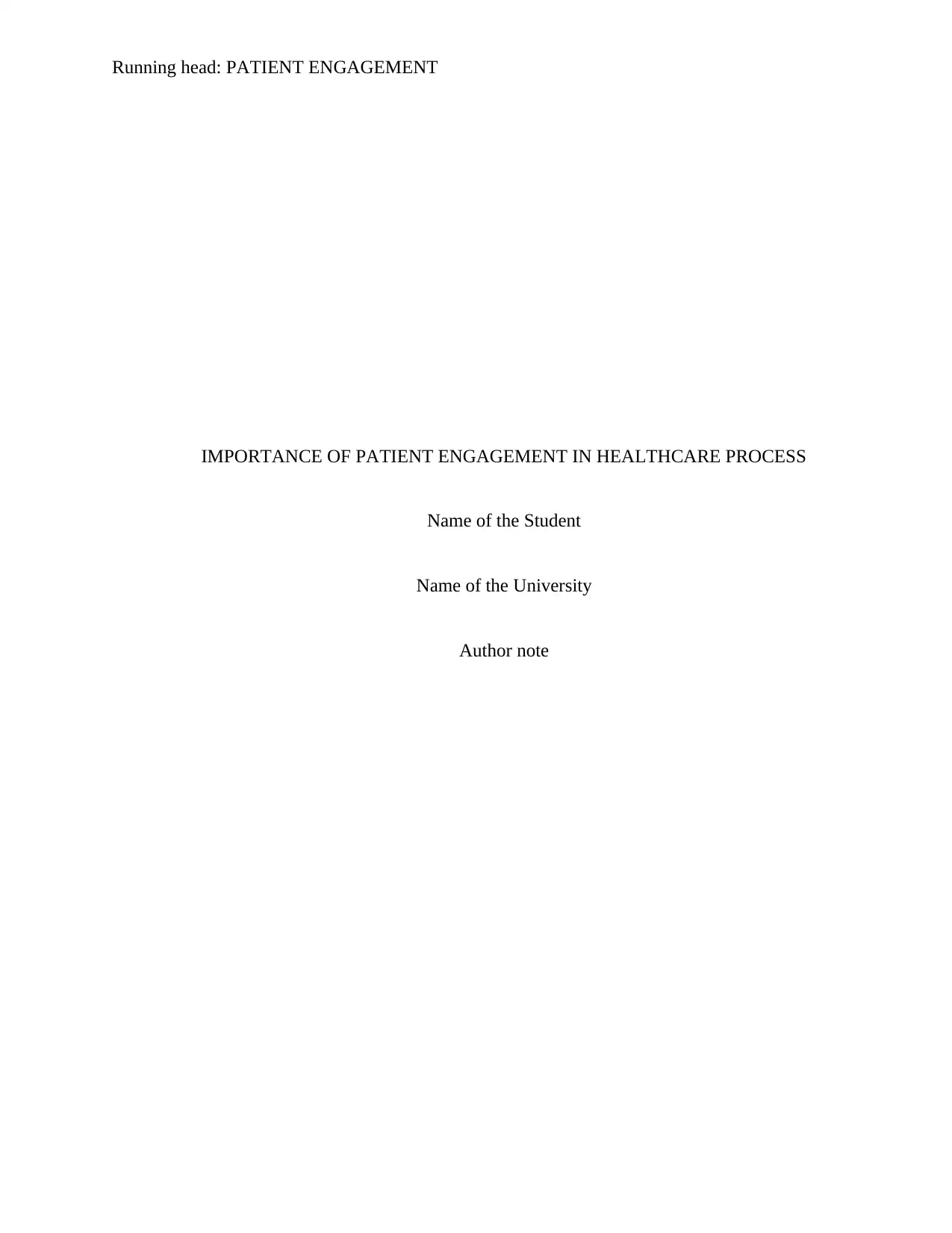
Running head: PATIENT ENGAGEMENT
IMPORTANCE OF PATIENT ENGAGEMENT IN HEALTHCARE PROCESS
Name of the Student
Name of the University
Author note
IMPORTANCE OF PATIENT ENGAGEMENT IN HEALTHCARE PROCESS
Name of the Student
Name of the University
Author note
Paraphrase This Document
Need a fresh take? Get an instant paraphrase of this document with our AI Paraphraser
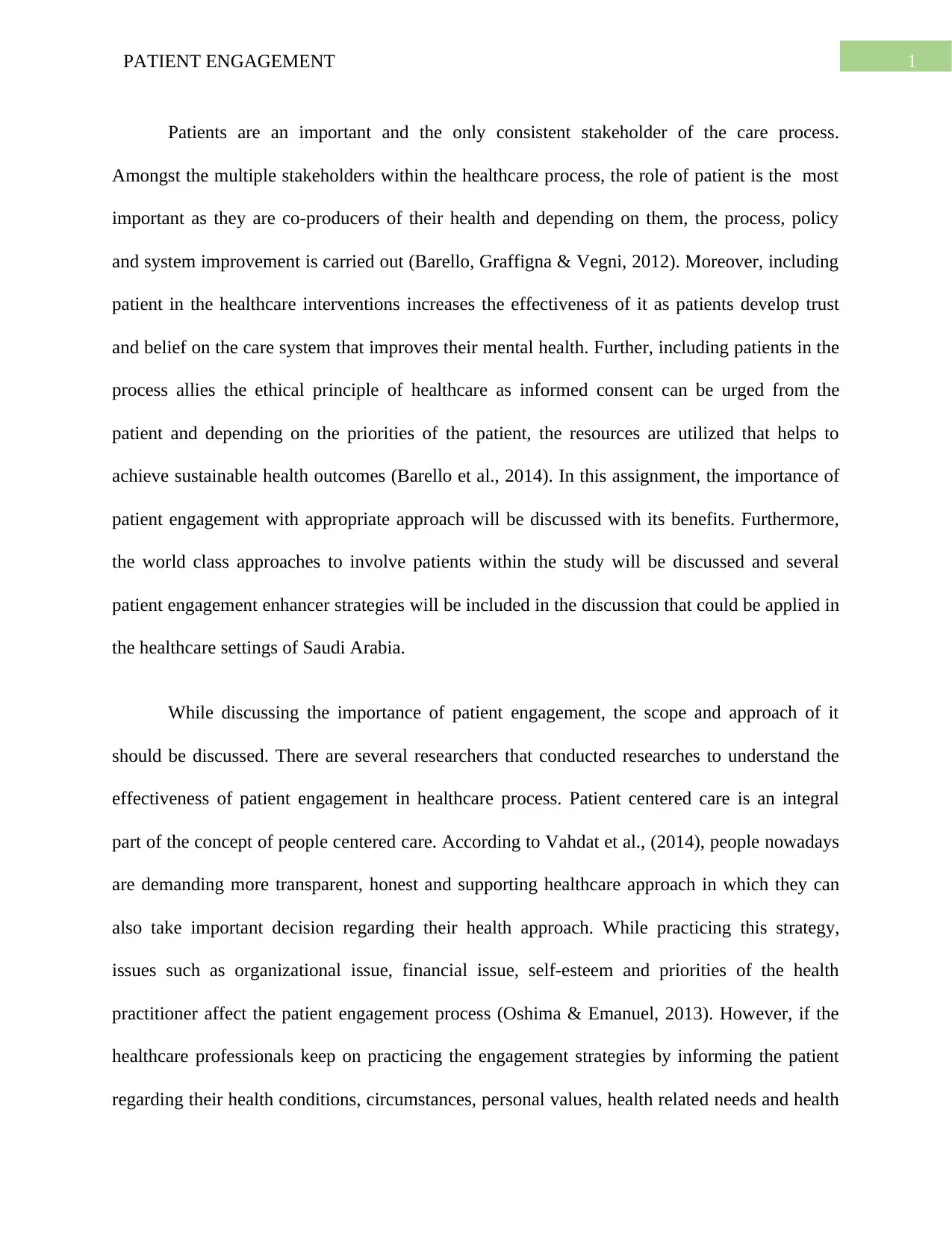
1PATIENT ENGAGEMENT
Patients are an important and the only consistent stakeholder of the care process.
Amongst the multiple stakeholders within the healthcare process, the role of patient is the most
important as they are co-producers of their health and depending on them, the process, policy
and system improvement is carried out (Barello, Graffigna & Vegni, 2012). Moreover, including
patient in the healthcare interventions increases the effectiveness of it as patients develop trust
and belief on the care system that improves their mental health. Further, including patients in the
process allies the ethical principle of healthcare as informed consent can be urged from the
patient and depending on the priorities of the patient, the resources are utilized that helps to
achieve sustainable health outcomes (Barello et al., 2014). In this assignment, the importance of
patient engagement with appropriate approach will be discussed with its benefits. Furthermore,
the world class approaches to involve patients within the study will be discussed and several
patient engagement enhancer strategies will be included in the discussion that could be applied in
the healthcare settings of Saudi Arabia.
While discussing the importance of patient engagement, the scope and approach of it
should be discussed. There are several researchers that conducted researches to understand the
effectiveness of patient engagement in healthcare process. Patient centered care is an integral
part of the concept of people centered care. According to Vahdat et al., (2014), people nowadays
are demanding more transparent, honest and supporting healthcare approach in which they can
also take important decision regarding their health approach. While practicing this strategy,
issues such as organizational issue, financial issue, self-esteem and priorities of the health
practitioner affect the patient engagement process (Oshima & Emanuel, 2013). However, if the
healthcare professionals keep on practicing the engagement strategies by informing the patient
regarding their health conditions, circumstances, personal values, health related needs and health
Patients are an important and the only consistent stakeholder of the care process.
Amongst the multiple stakeholders within the healthcare process, the role of patient is the most
important as they are co-producers of their health and depending on them, the process, policy
and system improvement is carried out (Barello, Graffigna & Vegni, 2012). Moreover, including
patient in the healthcare interventions increases the effectiveness of it as patients develop trust
and belief on the care system that improves their mental health. Further, including patients in the
process allies the ethical principle of healthcare as informed consent can be urged from the
patient and depending on the priorities of the patient, the resources are utilized that helps to
achieve sustainable health outcomes (Barello et al., 2014). In this assignment, the importance of
patient engagement with appropriate approach will be discussed with its benefits. Furthermore,
the world class approaches to involve patients within the study will be discussed and several
patient engagement enhancer strategies will be included in the discussion that could be applied in
the healthcare settings of Saudi Arabia.
While discussing the importance of patient engagement, the scope and approach of it
should be discussed. There are several researchers that conducted researches to understand the
effectiveness of patient engagement in healthcare process. Patient centered care is an integral
part of the concept of people centered care. According to Vahdat et al., (2014), people nowadays
are demanding more transparent, honest and supporting healthcare approach in which they can
also take important decision regarding their health approach. While practicing this strategy,
issues such as organizational issue, financial issue, self-esteem and priorities of the health
practitioner affect the patient engagement process (Oshima & Emanuel, 2013). However, if the
healthcare professionals keep on practicing the engagement strategies by informing the patient
regarding their health conditions, circumstances, personal values, health related needs and health
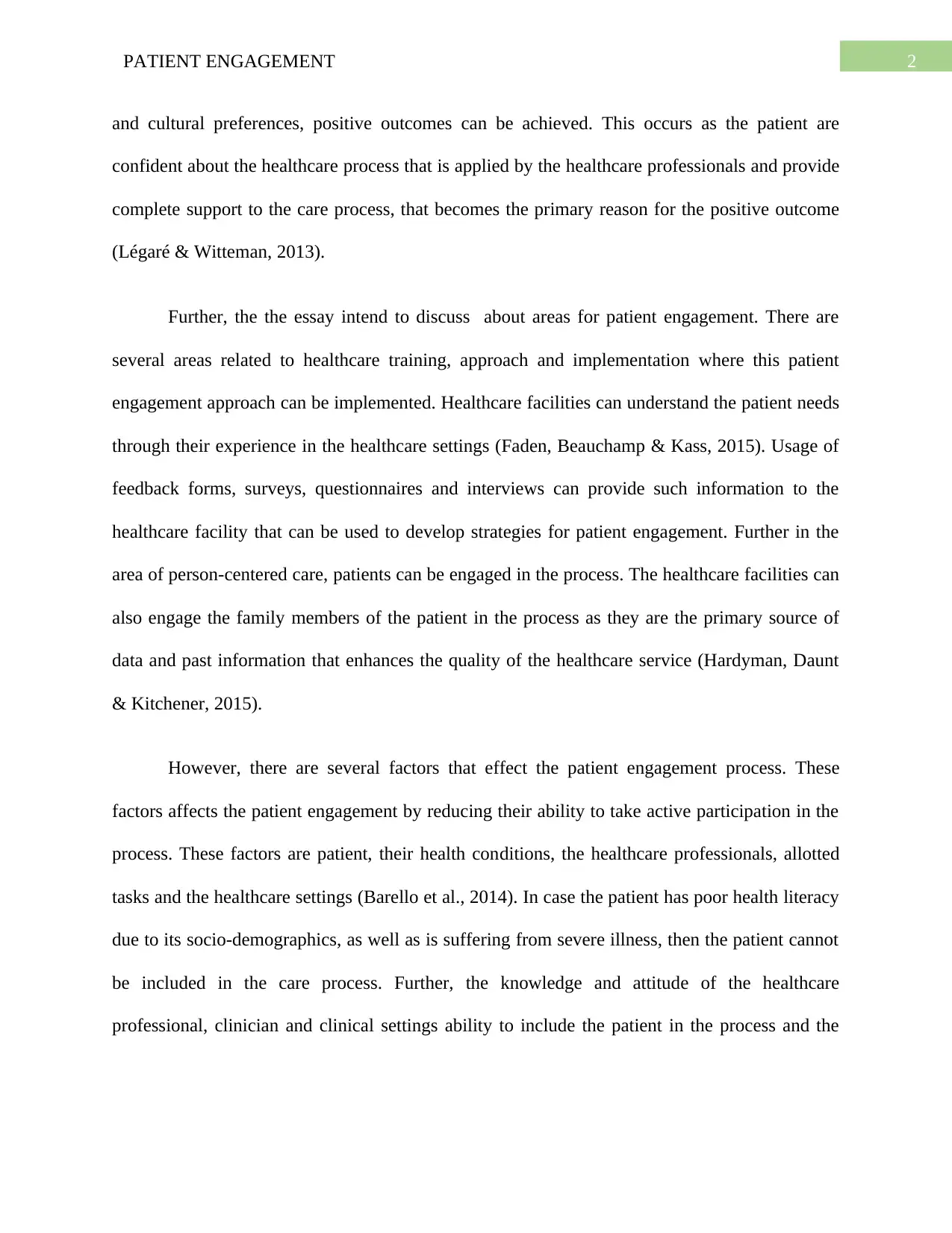
2PATIENT ENGAGEMENT
and cultural preferences, positive outcomes can be achieved. This occurs as the patient are
confident about the healthcare process that is applied by the healthcare professionals and provide
complete support to the care process, that becomes the primary reason for the positive outcome
(Légaré & Witteman, 2013).
Further, the the essay intend to discuss about areas for patient engagement. There are
several areas related to healthcare training, approach and implementation where this patient
engagement approach can be implemented. Healthcare facilities can understand the patient needs
through their experience in the healthcare settings (Faden, Beauchamp & Kass, 2015). Usage of
feedback forms, surveys, questionnaires and interviews can provide such information to the
healthcare facility that can be used to develop strategies for patient engagement. Further in the
area of person-centered care, patients can be engaged in the process. The healthcare facilities can
also engage the family members of the patient in the process as they are the primary source of
data and past information that enhances the quality of the healthcare service (Hardyman, Daunt
& Kitchener, 2015).
However, there are several factors that effect the patient engagement process. These
factors affects the patient engagement by reducing their ability to take active participation in the
process. These factors are patient, their health conditions, the healthcare professionals, allotted
tasks and the healthcare settings (Barello et al., 2014). In case the patient has poor health literacy
due to its socio-demographics, as well as is suffering from severe illness, then the patient cannot
be included in the care process. Further, the knowledge and attitude of the healthcare
professional, clinician and clinical settings ability to include the patient in the process and the
and cultural preferences, positive outcomes can be achieved. This occurs as the patient are
confident about the healthcare process that is applied by the healthcare professionals and provide
complete support to the care process, that becomes the primary reason for the positive outcome
(Légaré & Witteman, 2013).
Further, the the essay intend to discuss about areas for patient engagement. There are
several areas related to healthcare training, approach and implementation where this patient
engagement approach can be implemented. Healthcare facilities can understand the patient needs
through their experience in the healthcare settings (Faden, Beauchamp & Kass, 2015). Usage of
feedback forms, surveys, questionnaires and interviews can provide such information to the
healthcare facility that can be used to develop strategies for patient engagement. Further in the
area of person-centered care, patients can be engaged in the process. The healthcare facilities can
also engage the family members of the patient in the process as they are the primary source of
data and past information that enhances the quality of the healthcare service (Hardyman, Daunt
& Kitchener, 2015).
However, there are several factors that effect the patient engagement process. These
factors affects the patient engagement by reducing their ability to take active participation in the
process. These factors are patient, their health conditions, the healthcare professionals, allotted
tasks and the healthcare settings (Barello et al., 2014). In case the patient has poor health literacy
due to its socio-demographics, as well as is suffering from severe illness, then the patient cannot
be included in the care process. Further, the knowledge and attitude of the healthcare
professional, clinician and clinical settings ability to include the patient in the process and the
⊘ This is a preview!⊘
Do you want full access?
Subscribe today to unlock all pages.

Trusted by 1+ million students worldwide
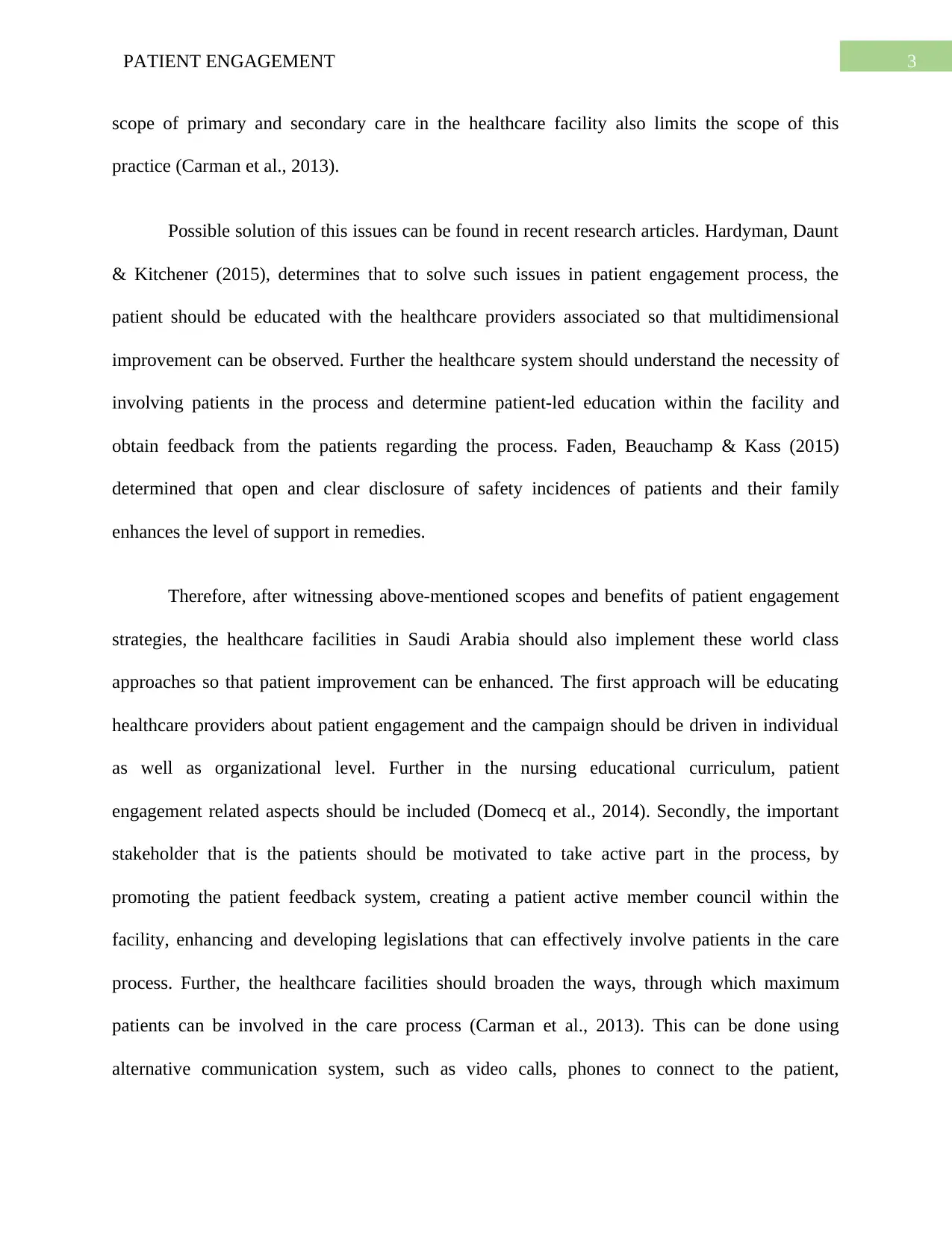
3PATIENT ENGAGEMENT
scope of primary and secondary care in the healthcare facility also limits the scope of this
practice (Carman et al., 2013).
Possible solution of this issues can be found in recent research articles. Hardyman, Daunt
& Kitchener (2015), determines that to solve such issues in patient engagement process, the
patient should be educated with the healthcare providers associated so that multidimensional
improvement can be observed. Further the healthcare system should understand the necessity of
involving patients in the process and determine patient-led education within the facility and
obtain feedback from the patients regarding the process. Faden, Beauchamp & Kass (2015)
determined that open and clear disclosure of safety incidences of patients and their family
enhances the level of support in remedies.
Therefore, after witnessing above-mentioned scopes and benefits of patient engagement
strategies, the healthcare facilities in Saudi Arabia should also implement these world class
approaches so that patient improvement can be enhanced. The first approach will be educating
healthcare providers about patient engagement and the campaign should be driven in individual
as well as organizational level. Further in the nursing educational curriculum, patient
engagement related aspects should be included (Domecq et al., 2014). Secondly, the important
stakeholder that is the patients should be motivated to take active part in the process, by
promoting the patient feedback system, creating a patient active member council within the
facility, enhancing and developing legislations that can effectively involve patients in the care
process. Further, the healthcare facilities should broaden the ways, through which maximum
patients can be involved in the care process (Carman et al., 2013). This can be done using
alternative communication system, such as video calls, phones to connect to the patient,
scope of primary and secondary care in the healthcare facility also limits the scope of this
practice (Carman et al., 2013).
Possible solution of this issues can be found in recent research articles. Hardyman, Daunt
& Kitchener (2015), determines that to solve such issues in patient engagement process, the
patient should be educated with the healthcare providers associated so that multidimensional
improvement can be observed. Further the healthcare system should understand the necessity of
involving patients in the process and determine patient-led education within the facility and
obtain feedback from the patients regarding the process. Faden, Beauchamp & Kass (2015)
determined that open and clear disclosure of safety incidences of patients and their family
enhances the level of support in remedies.
Therefore, after witnessing above-mentioned scopes and benefits of patient engagement
strategies, the healthcare facilities in Saudi Arabia should also implement these world class
approaches so that patient improvement can be enhanced. The first approach will be educating
healthcare providers about patient engagement and the campaign should be driven in individual
as well as organizational level. Further in the nursing educational curriculum, patient
engagement related aspects should be included (Domecq et al., 2014). Secondly, the important
stakeholder that is the patients should be motivated to take active part in the process, by
promoting the patient feedback system, creating a patient active member council within the
facility, enhancing and developing legislations that can effectively involve patients in the care
process. Further, the healthcare facilities should broaden the ways, through which maximum
patients can be involved in the care process (Carman et al., 2013). This can be done using
alternative communication system, such as video calls, phones to connect to the patient,
Paraphrase This Document
Need a fresh take? Get an instant paraphrase of this document with our AI Paraphraser
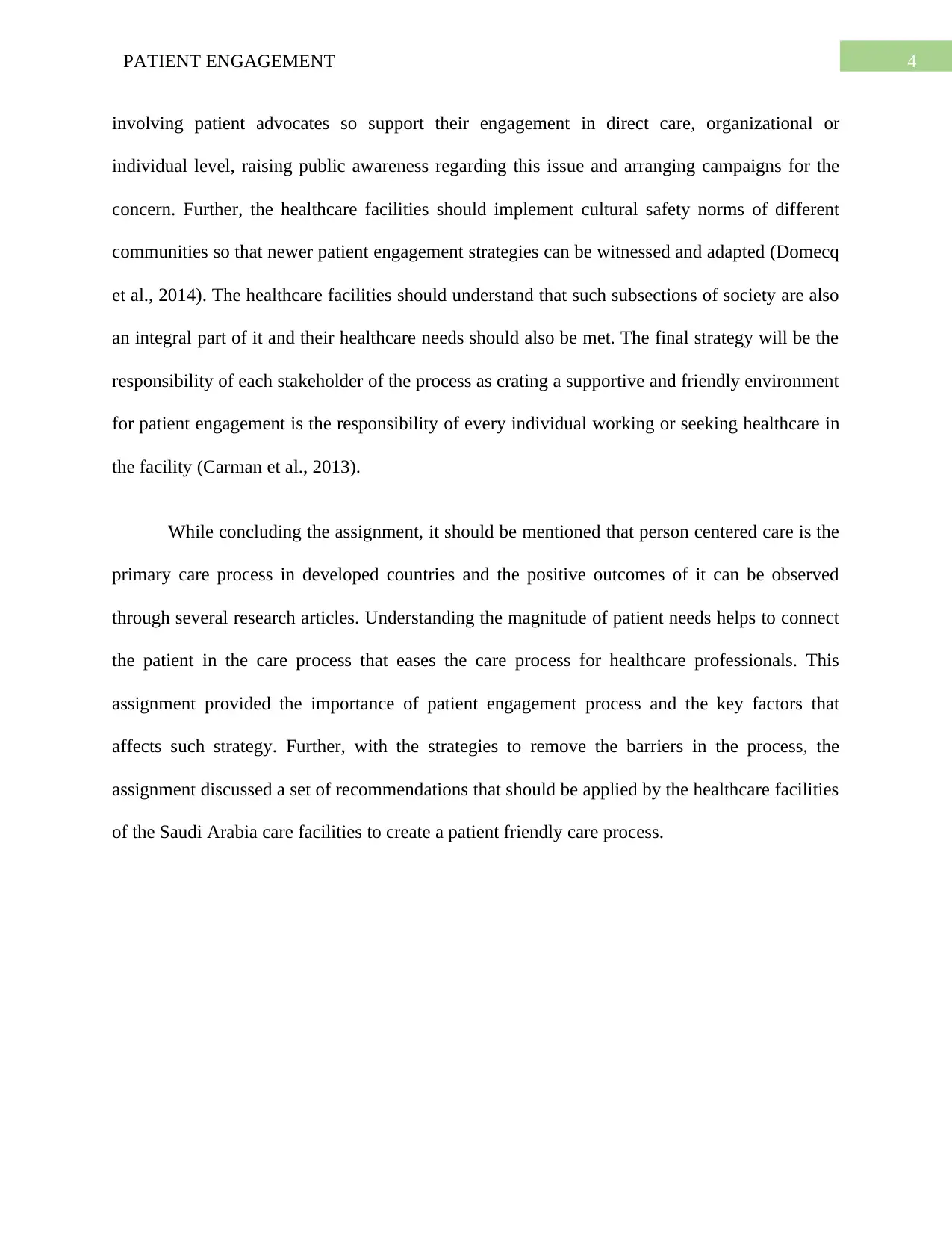
4PATIENT ENGAGEMENT
involving patient advocates so support their engagement in direct care, organizational or
individual level, raising public awareness regarding this issue and arranging campaigns for the
concern. Further, the healthcare facilities should implement cultural safety norms of different
communities so that newer patient engagement strategies can be witnessed and adapted (Domecq
et al., 2014). The healthcare facilities should understand that such subsections of society are also
an integral part of it and their healthcare needs should also be met. The final strategy will be the
responsibility of each stakeholder of the process as crating a supportive and friendly environment
for patient engagement is the responsibility of every individual working or seeking healthcare in
the facility (Carman et al., 2013).
While concluding the assignment, it should be mentioned that person centered care is the
primary care process in developed countries and the positive outcomes of it can be observed
through several research articles. Understanding the magnitude of patient needs helps to connect
the patient in the care process that eases the care process for healthcare professionals. This
assignment provided the importance of patient engagement process and the key factors that
affects such strategy. Further, with the strategies to remove the barriers in the process, the
assignment discussed a set of recommendations that should be applied by the healthcare facilities
of the Saudi Arabia care facilities to create a patient friendly care process.
involving patient advocates so support their engagement in direct care, organizational or
individual level, raising public awareness regarding this issue and arranging campaigns for the
concern. Further, the healthcare facilities should implement cultural safety norms of different
communities so that newer patient engagement strategies can be witnessed and adapted (Domecq
et al., 2014). The healthcare facilities should understand that such subsections of society are also
an integral part of it and their healthcare needs should also be met. The final strategy will be the
responsibility of each stakeholder of the process as crating a supportive and friendly environment
for patient engagement is the responsibility of every individual working or seeking healthcare in
the facility (Carman et al., 2013).
While concluding the assignment, it should be mentioned that person centered care is the
primary care process in developed countries and the positive outcomes of it can be observed
through several research articles. Understanding the magnitude of patient needs helps to connect
the patient in the care process that eases the care process for healthcare professionals. This
assignment provided the importance of patient engagement process and the key factors that
affects such strategy. Further, with the strategies to remove the barriers in the process, the
assignment discussed a set of recommendations that should be applied by the healthcare facilities
of the Saudi Arabia care facilities to create a patient friendly care process.
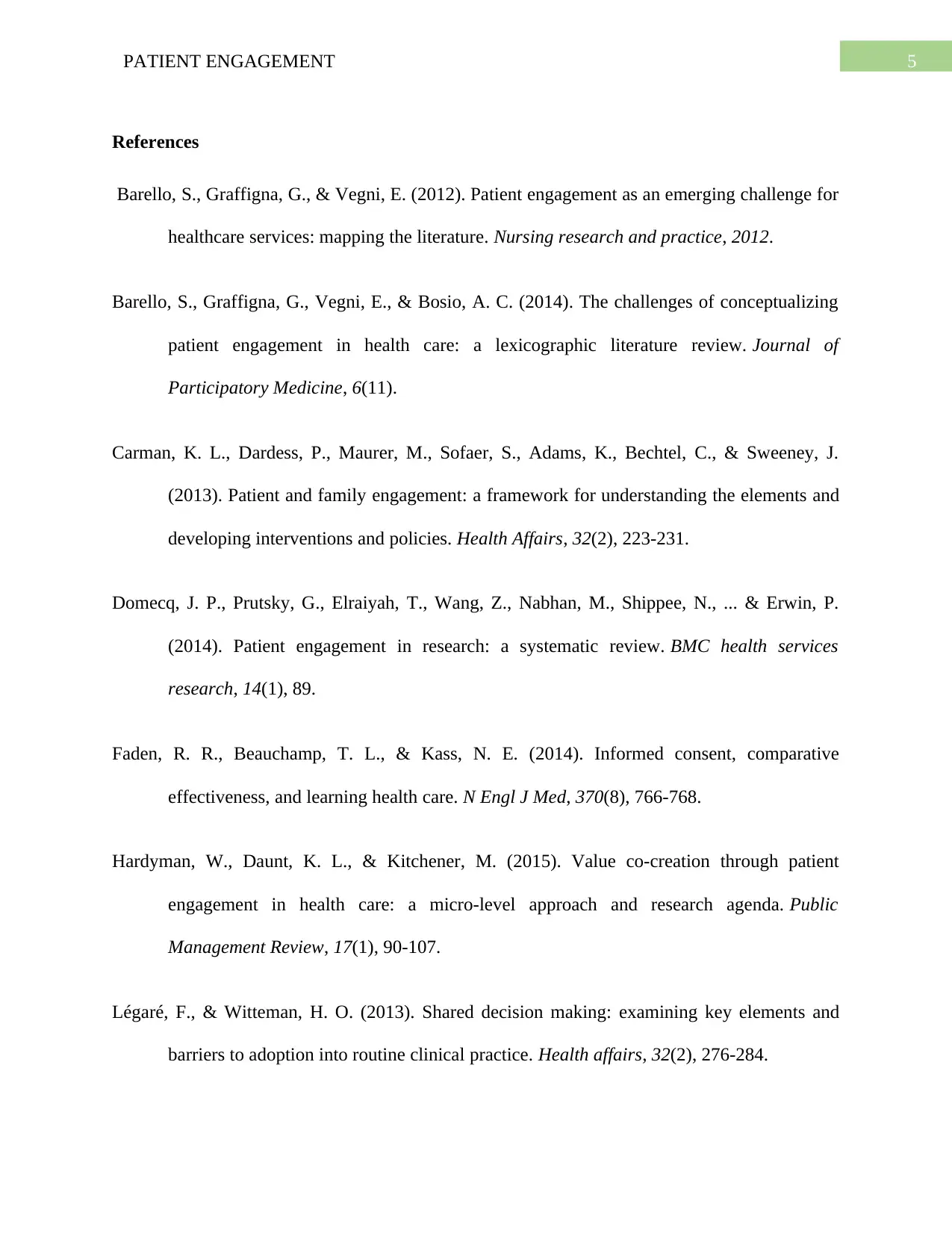
5PATIENT ENGAGEMENT
References
Barello, S., Graffigna, G., & Vegni, E. (2012). Patient engagement as an emerging challenge for
healthcare services: mapping the literature. Nursing research and practice, 2012.
Barello, S., Graffigna, G., Vegni, E., & Bosio, A. C. (2014). The challenges of conceptualizing
patient engagement in health care: a lexicographic literature review. Journal of
Participatory Medicine, 6(11).
Carman, K. L., Dardess, P., Maurer, M., Sofaer, S., Adams, K., Bechtel, C., & Sweeney, J.
(2013). Patient and family engagement: a framework for understanding the elements and
developing interventions and policies. Health Affairs, 32(2), 223-231.
Domecq, J. P., Prutsky, G., Elraiyah, T., Wang, Z., Nabhan, M., Shippee, N., ... & Erwin, P.
(2014). Patient engagement in research: a systematic review. BMC health services
research, 14(1), 89.
Faden, R. R., Beauchamp, T. L., & Kass, N. E. (2014). Informed consent, comparative
effectiveness, and learning health care. N Engl J Med, 370(8), 766-768.
Hardyman, W., Daunt, K. L., & Kitchener, M. (2015). Value co-creation through patient
engagement in health care: a micro-level approach and research agenda. Public
Management Review, 17(1), 90-107.
Légaré, F., & Witteman, H. O. (2013). Shared decision making: examining key elements and
barriers to adoption into routine clinical practice. Health affairs, 32(2), 276-284.
References
Barello, S., Graffigna, G., & Vegni, E. (2012). Patient engagement as an emerging challenge for
healthcare services: mapping the literature. Nursing research and practice, 2012.
Barello, S., Graffigna, G., Vegni, E., & Bosio, A. C. (2014). The challenges of conceptualizing
patient engagement in health care: a lexicographic literature review. Journal of
Participatory Medicine, 6(11).
Carman, K. L., Dardess, P., Maurer, M., Sofaer, S., Adams, K., Bechtel, C., & Sweeney, J.
(2013). Patient and family engagement: a framework for understanding the elements and
developing interventions and policies. Health Affairs, 32(2), 223-231.
Domecq, J. P., Prutsky, G., Elraiyah, T., Wang, Z., Nabhan, M., Shippee, N., ... & Erwin, P.
(2014). Patient engagement in research: a systematic review. BMC health services
research, 14(1), 89.
Faden, R. R., Beauchamp, T. L., & Kass, N. E. (2014). Informed consent, comparative
effectiveness, and learning health care. N Engl J Med, 370(8), 766-768.
Hardyman, W., Daunt, K. L., & Kitchener, M. (2015). Value co-creation through patient
engagement in health care: a micro-level approach and research agenda. Public
Management Review, 17(1), 90-107.
Légaré, F., & Witteman, H. O. (2013). Shared decision making: examining key elements and
barriers to adoption into routine clinical practice. Health affairs, 32(2), 276-284.
⊘ This is a preview!⊘
Do you want full access?
Subscribe today to unlock all pages.

Trusted by 1+ million students worldwide
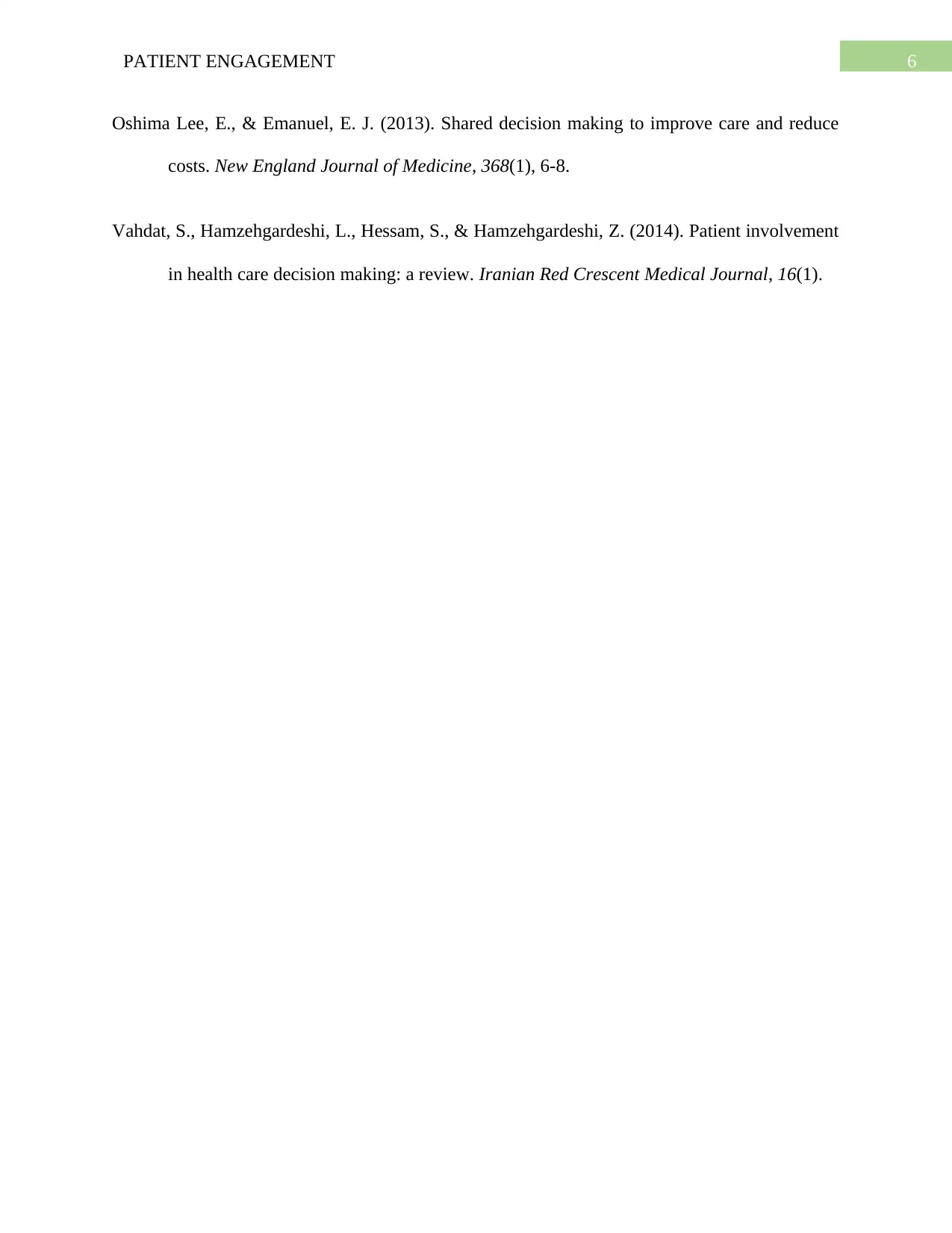
6PATIENT ENGAGEMENT
Oshima Lee, E., & Emanuel, E. J. (2013). Shared decision making to improve care and reduce
costs. New England Journal of Medicine, 368(1), 6-8.
Vahdat, S., Hamzehgardeshi, L., Hessam, S., & Hamzehgardeshi, Z. (2014). Patient involvement
in health care decision making: a review. Iranian Red Crescent Medical Journal, 16(1).
Oshima Lee, E., & Emanuel, E. J. (2013). Shared decision making to improve care and reduce
costs. New England Journal of Medicine, 368(1), 6-8.
Vahdat, S., Hamzehgardeshi, L., Hessam, S., & Hamzehgardeshi, Z. (2014). Patient involvement
in health care decision making: a review. Iranian Red Crescent Medical Journal, 16(1).
1 out of 7
Related Documents
Your All-in-One AI-Powered Toolkit for Academic Success.
+13062052269
info@desklib.com
Available 24*7 on WhatsApp / Email
![[object Object]](/_next/static/media/star-bottom.7253800d.svg)
Unlock your academic potential
Copyright © 2020–2025 A2Z Services. All Rights Reserved. Developed and managed by ZUCOL.




